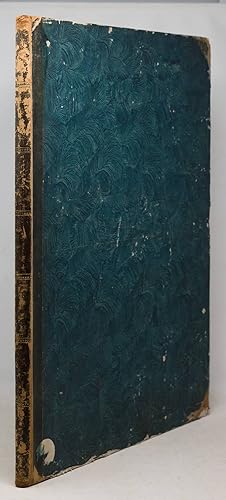About this Item
FROM THE LIBRARY OF WILLIAM S. REESE. [Rome: no publisher, 1819.] Broadsheet folio (19 1/4" x 13 7/8", 493mm x 352mm): 21 aquatint-engraved plates (two with two views), of which 17 or so are printed in sepia. Preceded by a tissue guard inscribed in graphite "L. Caracciolo/ 1819=/ Prove di Acqua tinta". 18 of the plates avant la lettre and titled (or partially-titled) in graphite. Bound in contemporary half green straight-grained morocco over blue paste-paper boards. On the spine, seven panels divided by gilt rolls. Worn broadly, with significant rubbing to the spine. Remnants of a circular paper label to the front board. Marginal toning and a little foxing. Book-label of William S. Reese to the front paste-down. Erased graphite ownership inscription of W. Dickinson along with shelfmarking (?) to the recto of the front free end-paper. In a single volume is told a great deal of the development of European identity in the era of the Grand Tour. Ludovico Caracciolo (1761-1842), an Italian artist and engraver, cut plates after the drawings of the English architect Henry Wilkins (1767-1847) for publication in French as a "Suite de Vues Pittoresques des Ruines de Pompeii." Although little is known of Wilkins, Caracciolo ranks among the great illustrators of Italy. Several of his sketchbooks are preserved in Rome at the Biblioteca di Archeologia e Storia dell'Arte di Roma (BiASA); he documented the excavations at Rome as so many of his predecessors had done. The excavation of Pompeii, which was buried in pyroclastic flow and ash from the eruption of the volcano Vesuvius in AD 79, began in earnest in 1748. Charles III of Spain (1716-1788; Charles I, Duke of Parma and Piacenza; Charles VII King of Naples; Charles V King of Naples) built a palace at Portici, southeast of Naples and quite close to Herculaneum, another of the cities destroyed by Vesuvius. Aware of the nascent excavations, Charles appointed Roque Joaquín de Alcubierre, a Spanish military engineer, to make systematic efforts and to extract the finest material to adorn his Portici palace. By February 1819 (the terminus cited in the title) major excavations had finished in the forum, uncovering some truly remarkable sites as well as paintings, mosaics and objects. Meanwhile the domain that encompassed archaeological site, the Kingdom of Naples, had merged with the Kingdom of Sicily to become the Kingdom of Two Sicilies. The kingdom passed into Bourbon hands -- including rule by Napoleon's elder brother Joseph (Giuseppe) 1806-1808, Joachim Murat 1808-1815 and finally Ferdinand I -- hence the publication in French. The present item brings together 23 of the eventual 32 plates (including a map) as proofs, largely before the inclusion of text ("avant la lettre"), captioned and occasionally marked in, presumably, Caracciolo's own hand. In one case, the tomb of Tyche (pl. 7/VII), the final word only is supplied in manuscript, the rest being on the stone. The manuscript is in Italian, whereas the plates in the printed work are captioned or titled in French. There are occasional iconographic changes between the proofs and the printed work (per the example digitized by the Bibliothèque national de France). Most tantalizing is the erased ownership signature of "W. Dickinson." Could this be William Dickinson (1746-1823), the great English mezzotint engraver, publisher and print-seller? Among his most famous prints depicts Georgiana, Duchess of Devonshire (with the Viscountess Duncannon) after a painting by Angelica Kaufmann; Caracciolo was the protègé of Bess (Foster) Cavendish, Georgiana's confidante and successor as duchess. These proofs may have come into the collection of the engraver, to whom they will doubtless have been of great technical interest. From the collection of William S. Reese (his sale, Christie's New York, 25 May 2022, lot 296). Reese (1955-2018) collected plate books in particular. His firm continues to trade in New Haven. Seller Inventory # JLR0415
Contact seller
Report this item
![]()




